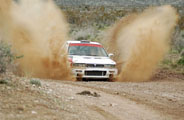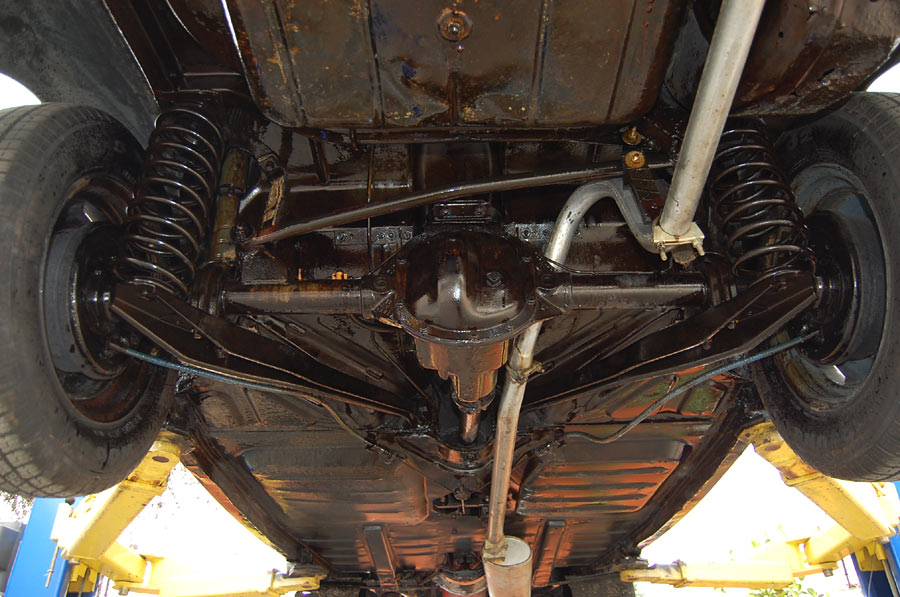4 link v 3 link
Posted by tdrrally
Pete Pete Remner Elite Moderator Location: Cleveland, Ohio Join Date: 01/11/2006 Age: Midlife Crisis Posts: 2,022 |
The circle track guys do bizarre things with multiple upper links mounted to the same location on one end, with sliders and rubbers and springs in them, so the axle pulls on one under acceleration (big heaps anti squat) and pushes on the other under braking (neutral antidive)... And then it gets even more complicated than that. Good if you're only concerned about a smooth oval and axle motion isn't something you need to worry about except for exploiting it for changing tire loadings. Pete Remner Cleveland, Ohio 1984 RX-7 (rallycross thing) 1978 Silence is golden, but duct tape is silver. |
Pete Pete Remner Elite Moderator Location: Cleveland, Ohio Join Date: 01/11/2006 Age: Midlife Crisis Posts: 2,022 |
Move the Panhard lower, and you have basically the same rear suspension NASCAR teams have used since the 60s/70s. Pete Remner Cleveland, Ohio 1984 RX-7 (rallycross thing) 1978 Silence is golden, but duct tape is silver. |
tdrrally edward mucklow Super Moderator Location: charleston,wv Join Date: 05/31/2011 Age: Possibly Wise Posts: 763 Rally Car: ford mustang LX 5.0, 1973 VW Beetle |
well this took off! lol
my car has a 100" wheelbase and a fare amount of room for longer lower arms stock being about 17 1/2" i do plan to keep the panhard bar or the like right now i have the steeda 5 link i know its not super HD but its paid for.and if its still good later i will out it on the cone crucher 2k v6 http://www.steeda.com/steeda-mustang-5-link-rear-suspension-system-555-2501/ I would rather drive a slow car fast as a fast car slow! first rule of cars: get what makes you happy, your the one paying for it! |
hoche Michel Hoche-Mong Super Moderator Location: Campbell, CA Join Date: 02/28/2006 Age: Possibly Wise Posts: 1,156 Rally Car: Golf, Golf, RX-3 |
|
tdrrally edward mucklow Super Moderator Location: charleston,wv Join Date: 05/31/2011 Age: Possibly Wise Posts: 763 Rally Car: ford mustang LX 5.0, 1973 VW Beetle |
|
tdrrally edward mucklow Super Moderator Location: charleston,wv Join Date: 05/31/2011 Age: Possibly Wise Posts: 763 Rally Car: ford mustang LX 5.0, 1973 VW Beetle |
WOW!
http://www.race-dezert.com/forum/threads/toyota-mteg-stadium-truck-build.95490/ I would rather drive a slow car fast as a fast car slow! first rule of cars: get what makes you happy, your the one paying for it! |
Pete Pete Remner Elite Moderator Location: Cleveland, Ohio Join Date: 01/11/2006 Age: Midlife Crisis Posts: 2,022 |
That stadium truck restoration was also on SpecialStage. Looks trick. I drool over the magnesium Dana 60.
But yeah, they settled on that because it works really, really well for their purpose. Just like the equal length 4 link seems to work really, really well for stage rally. Pete Remner Cleveland, Ohio 1984 RX-7 (rallycross thing) 1978 Silence is golden, but duct tape is silver. |
john vanlandingham John Vanlandingham Ultra Moderator Location: Ford Asylum, Sleezattle, WA Join Date: 12/20/2005 Age: Fossilized Posts: 14,152 Rally Car: Saab 96 V4 |
Once again:
John Vanlandingham Sleezattle, WA, USA Vive le Prole-le-ralliat www.rallyrace.net/jvab CALL +1 206 431-9696 Remember! Pacific Standard Time is 3 hours behind Eastern Standard Time. Edited 1 time(s). Last edit at 05/24/2016 01:34AM by john vanlandingham. |
tdrrally edward mucklow Super Moderator Location: charleston,wv Join Date: 05/31/2011 Age: Possibly Wise Posts: 763 Rally Car: ford mustang LX 5.0, 1973 VW Beetle |
so with my 100" wb the escort stuff is close.
i will say i like the way the celica TCT rear suspension looked and seemed to perform I would rather drive a slow car fast as a fast car slow! first rule of cars: get what makes you happy, your the one paying for it! |
john vanlandingham John Vanlandingham Ultra Moderator Location: Ford Asylum, Sleezattle, WA Join Date: 12/20/2005 Age: Fossilized Posts: 14,152 Rally Car: Saab 96 V4 |
I believe your wheelbase is 100.5" so 6% longer...the question becomes "is there room to position the boxes such that I can go to longer links than the 94.5" car did?" Tape measure center of rear spindle/hub to just aft of the rear or the seat.. The longer the better...less arc, more predictable. John Vanlandingham Sleezattle, WA, USA Vive le Prole-le-ralliat www.rallyrace.net/jvab CALL +1 206 431-9696 Remember! Pacific Standard Time is 3 hours behind Eastern Standard Time. |
tdrrally edward mucklow Super Moderator Location: charleston,wv Join Date: 05/31/2011 Age: Possibly Wise Posts: 763 Rally Car: ford mustang LX 5.0, 1973 VW Beetle |
i will put the tape to the real world in a couple days, but i would say its close to 30" like i said i will conform the numbers in a day or so and take some pix too. I would rather drive a slow car fast as a fast car slow! first rule of cars: get what makes you happy, your the one paying for it! |
john vanlandingham John Vanlandingham Ultra Moderator Location: Ford Asylum, Sleezattle, WA Join Date: 12/20/2005 Age: Fossilized Posts: 14,152 Rally Car: Saab 96 V4 |
Yeah that sounds doable--counting the ends and stuff. John Vanlandingham Sleezattle, WA, USA Vive le Prole-le-ralliat www.rallyrace.net/jvab CALL +1 206 431-9696 Remember! Pacific Standard Time is 3 hours behind Eastern Standard Time. |
tdrrally edward mucklow Super Moderator Location: charleston,wv Join Date: 05/31/2011 Age: Possibly Wise Posts: 763 Rally Car: ford mustang LX 5.0, 1973 VW Beetle |
I confirmed today i have 30" from the center of the rear axle to the leading edge of the rear seat, at this point i will be adding a subframe connector from the rocker panel the front to rear subframe connector that the cage will be built on.
I would rather drive a slow car fast as a fast car slow! first rule of cars: get what makes you happy, your the one paying for it! |
Sorry, only registered users may post in this forum.
Rally Anarchy © 2014 Corvus Digital –
Part of the AutoShrine Network –
Problems? Send an email to the Webmaster










